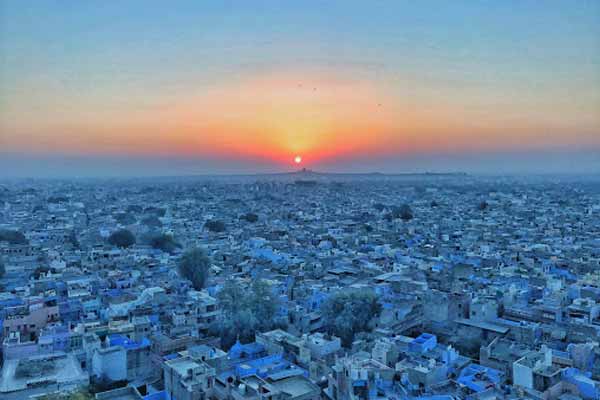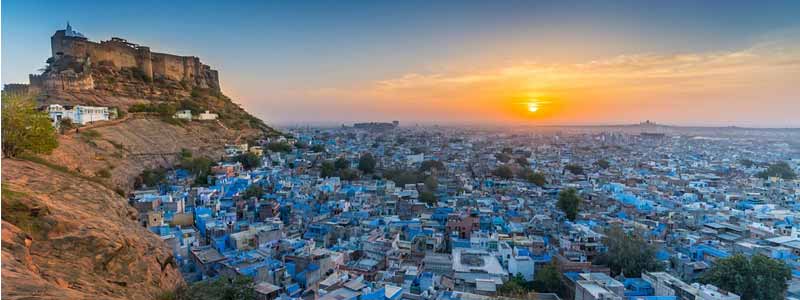Tourist Attractions Blue City Jodhpur is one of the most visited tourist attractions in Rajasthan, primarily because of the number of things that can be seen here. We have created a list of places to visit in Jodhpur to make your choice easier, with temples, fortresses, palaces, parks, markets and more to explore in Rajasthan.
The town was established in 1459 by Rao Jodha, from the Kingdom of Marwar, when he began to establish the great fort of Mehrangarh. Although Mandore was the town’s capital initially, Jodhpur quickly became Marwar’s capital. With a strong population expansion around the city in recent decades, the entire city has been developed in and around the fort. The city has benefited greatly from commerce and business, making it one of the most prosperous cities in Rajasthan, thanks to the strategic position of the city in the Gujarat belt in Delhi. Through the numerous palaces, temples and other structures spread around the town, we can see the riches.

Jodhpur is one of Rajasthan’s main cities and the best time to visit Rajasthan each year is between October and March. Jodhpur is the former capital of Marwar and it is famous for its Mehrangarh Fort, Jaswant Tada and Umaid Bhawan Palace. Thanks to its blue walls, homes, lakes and its overall aerial views, the city is called the Tourist Attractions Blue City Jodhpur.
Top Sightseeing Attractions in India’s Blue City – Jodhpur
Jodhpur is India’s renowned “Blue City” and you quickly see why once you arrive. The majestic Mehrangarh Fort, carved on top of the mountain, whips up tales of the past of the period when kings ruled the desert area of Rajasthan, adorned in jewels of deep royal blues. In this guide, I’ll show you all the best places to visit in Jodhpur, the ‘Blue City’ of India.

Mehrangarh Fort
Mehrangarh Fort is an architectural marvel, besides being associated with diverse history and cultural heritage. In the state of Rajasthan, the fort is considered one of the stunning forts. The castle of Mehrangarh, located in Jodhpur, is possibly the largest fort in India.
Work was done here on the Rao Jodha route around 1459, and arrangements were made at a distance of 410 feet to reinforce the city. Some of the present-day castles, surrounded by their borders, have remote locations to understand their surprising desire. When the town starts to descend, a zig zag means The Ketri Singh Soda Umbrella on one side of the stronghold is,A warrior who knocks on the security of the Mehrangarh. The name of the fort of Mehrangarh is derived from Mehr-Garh: Mehr means the sun and Fort means Garh. Owing to the pronunciation of the local language, Mehr-Garh came to be known as Tourist Attractions Blue City Jodhpur.
The historic centre inside Mehrangarh Fort is a well-furnished gallery shop in Rajasthan. The inner stronghold is the ghetto stronghold, a rickshaw in the present period, and custodian of the Expand County, which fought against the Gujarat ruler. The historical center exhibits legacies of customs, passports, costumes, and a vibrant age of fine arts. The fort in Mehrangarh is a wonderful Rajasthan museum. Here is a collection of old royal palaces in the single part of the castle museum, as well as the large dome gilded mahdol palki fought by the governor of Gujarat in 1730. The weapons, costumes, and history of the Rathore are displayed in the museum. Paintings and times of decorations.
Jaswant Thada
Jaswant Thada of Rajasthan, Jodhpur. It is a 19th-century royal cenotaph built in commemoration of Maharaja Jaswant Singh II, the 33rd Rathore ruler of Jodhpur. The son of Maharaja Jaswant Singh, Maharaja Sardar Singh, constructed the Jaswant Thada in memory of his father. Within it, the cenotaph has two more tombs. The royal crematorium and three other cenotaphs are nearby.
An instance of architectural excellence in India is the famous Jaswant Thada in Jodhpur, India. It is a memorial of white marble, made out of intricately carved marble boards. The carving shows the sculptors’ genius. These stones are extremely thin and polished. As a result, when the sun’s rays land on its surface, the outer surface of the monument emits a warm glow. There is also exquisite marble jali work on the cenotaph. In front of the cenotaph, you can have some nice views from the terrace Tourist Attractions Blue City Jodhpur.
The cenotaph of Maharaja Jaswant Singh shows portraits of the rulers and Maharajas of Jodhpur. The main memorial has been built like a temple. You have to go through the rugged hills in order to visit Thada. This also gives the entire visit a magical aura. While on a tour of Jodhpur, Rajasthan, make sure you visit this architectural delight.
Balsamand Lake and Garden
Balsamand Lake on Jodhpur – Mandore Road is an artificial lake located in Mandore. It is one of Jodhpur’s popular places to visit.
The Gurjara-Pratihara rulers founded Balsamand Lake in 1159 AD as a reservoir in the Mandore area to provide water. The lake is one kilometer in length, 50 m wide and 15 m deep. The lake is surrounded by green, lush gardens that house mango, papaya, pomegranate, guava and plum groves. An artificial cascading waterfall brings to the gardens water from the reservoir. In front of the palace, the embankments of the lake have domed structures that offer fabulous views of the lake. Visitors can also see animals and birds roaming in the area, including peacock, jackal and blue bull
The Balsamand Palace, which was constructed in 1936 by Maharaja Sur Singh, is on the banks of the lake. The palace used to be the summer resort of Jodhpur’s Maharajas, and because of its ornate and elegant architecture, the palace is constructed in red sandstone and is actually an eye retreat. This 8-pillared castle, with its grand architecture, has 3 gates for entry purposes and is one of the best heritage Tourist Attractions Blue City Jodhpur.
Mahamandir
In the city of Jodhpur, Mahamandir Temple is a Hindu temple located on Mandore road. It is one of the famous places in Jodhpur to visit.
Established in 1812 CE, Mahamandir Temple is well known for its wonderful piece of architecture that stands on 84 beautifully sculpted pillars. These pillars reveal exquisite carvings of stone representing yoga postures. Lord Shiva is dedicated to this temple. Well-designed traditional motifs are studded on this temple’s pillars and walls.
People throng this Temple in huge numbers and besides worshipping, they like to witness the beauty and art that is present in this temple which is really appreciating. The numerous yogic postures add to the charm of its, as well as enriching the knowledge of followers of yoga about the actual postures.
Mandore Gardens
Mandore Garden, the ancient capital of Marwar, is eight km from the city, with its original name being Mandavyapur. Near Jodhpur, Mandore Gardens is a historic site in Rajasthan. There are beautifully carved cenotaphs in the former capital of Marwar in the midst of gardens and the ” shrine of the 300 million gods,” featuring a row of giant painted portraits of deities and mythological heroes.
Mandore was the capital of the Pratihara Dynasty from the 6th to the 9th centuries. Due to enhanced safety considerations and consideration, the ruling dynasties retained lordship over the area from Mandore until the capital of Marwar was transferred to Jodhpur in 1459 AD. You can still trace the remains of the ancient capital of Marwar here. There are many historical monuments in the town of Marwar, including Mandore Fort, the old Mandore Palace and the Ravan Temple.
Mandodari, the wife of King Ravan the ghost, was a part of Mandore. Therefore, the temple of Ravan, the son-in-law of the people of Mandore, was built here to honor him. Mandore Gardens‘ rich flora and fauna create captivating natural landscapes. Royal garden cenotaphs are worth watching for history buffs and archaeological buffs. The cenotaphs of the rulers in sandstone, constructed in shaiva and Buddhist styles, can be seen in the midst of a wide garden.
Tourist Attractions Blue City Jodhpur must be seen in a temple with the Hindu Gods Pantheon and Government Museum in Mandore. Among other fascinating monuments to be visited in Mandore are cenotaph of Maharaja Ajeet Singh and ‘Hall of Heroes’ which commemorates the folk heroes and famous Rajputs of the region. Also seen here is a 4th century temple in ruins. The atmosphere, with many shrines and monuments, is soothing and blissful. Nearby is the palace of Maharaja Abhaya Singh.
Umaid Bhawan Palace Museum
Umaid Bhawan Palace is a royal palace in Rajasthan, India, situated on Chittar Hill in Jodhpur District. It is one of the largest private residences in the world and also one of the popular tourist places in Jodhpur.
Umaid Bhawan Palace is named after the grandfather of the new Maharaja Gaj Singh, Maharaja Umaid Singh. Maharaja Umaid Singh had laid the foundations of this opulent 347 room edifice on 18th November, 1929. However, the construction work started in 1943. Completion took 16 years. This sandstone monument is the only palace that was constructed for a noble cause in the 20th century. During a long period of drought and famine, the purpose was to give the people of Jodhpur employment.
Located on Chittar Hill, Jodhpur’s highest point, the palace is a fusion of architectural influences from India and Europe. The palatial building was designed by the Edwardian architect Henry Vaughan Lanchester and the Indian architect Budhmal Rai. The building’s prominent central dome, which is a 32 m high cupola, was inspired by the Renaissance. The palace towers are influenced by the Rajput culture. In the architecture of the palace, a fusion of Art Deco and millennia-old Hindu architectural styles is evident Tourist Attractions Blue City Jodhpur.
There are two main wings of the beautiful Umaid Bhawan Palace. The royal residence is served by one wing of the Umaid Bhawan Palace. Maharaja Umaid Singh’s grandson, Maharaja Gaj Singh, still lives with his family here. The palace’s other wing now serves as a heritage hotel. This wing is owned by the Taj Group of Hotels, which operates a five-star heritage hotel set among 26 acres of lush gardens. Umaid Bhawan Palace, also known as Chittar Palace, is regarded as India’s most elegant and beautiful architecture in the world and the most luxurious heritage hotels.
Ghanta Ghar
Also known as the Clock Tower, Ghanta Ghar is a prominent landmark in the old city of Jodhpur. The vibrant Sardar Market is Jodhpur’s popular shopping area near the Ghanta Ghar, and narrow alleys lead from here to a bazaar selling spices, Indian sweets, textiles, vegetables, silver, and crafts. This is a perfect place for free time to ramble about. Because of the Sadar Market, Ghanta Ghar is the busiest place in Jodhpur. Between 1880 and 1991, the late Maharaja Sardar Singh designed Ghanta Ghar in Jodhpur; it is more of an architectural pleasure.
A fine example of 19th Century stone masonry is Ghanta Ghar. It is made entirely of sandstone, in accordance with the Mehrangarh Fort sandstone in the backdrop. The vibrant market area can also be seen as curious, as the entire region is known for selling a wide and fine range of handicrafts, such as Rajasthani sarees and kurtas, local crafts, bangles, souvenirs, and much more. Crammed with more than 7000 small and large shops, the entire area is the dream come true of a shopaholic. Ghanta Ghar is just the place to be for everyone in the city finding shopping choices.